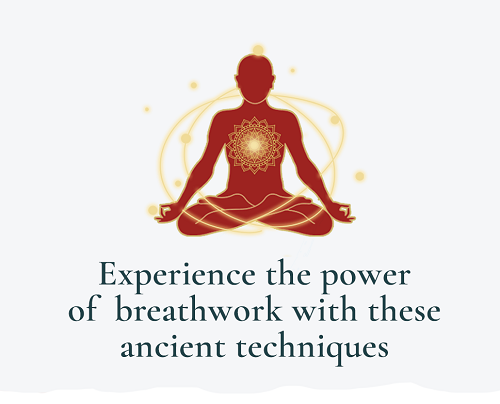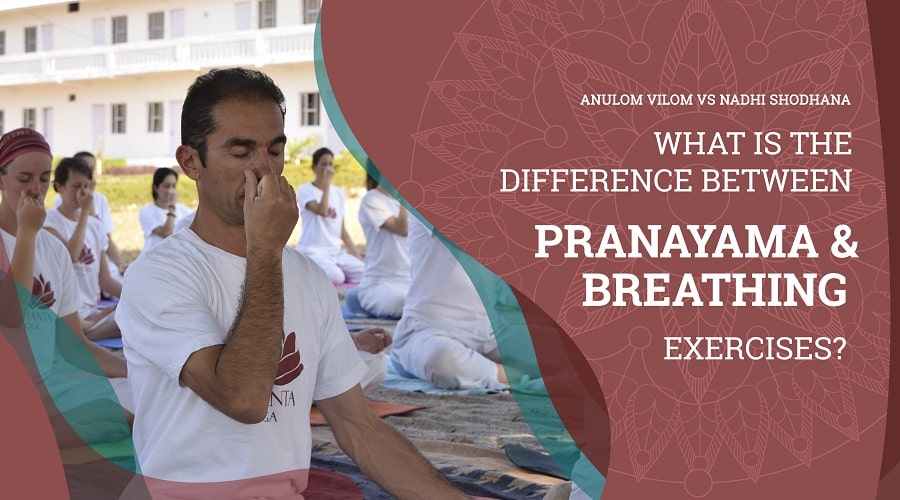When referring to yoga breathing exercises, the term 'Pranayama' is often used. However, not all yoga breathing exercises are Pranayama. In fact, most aren't. The term Pranayama literally means “expansion of life force (prana) and its purpose is to improve the body’s capacity to retain and increase prana in the body.
In order to increase the body's ability to retain prana, Pranayama purifies our energy channels (Nadis). Over time and with regular practice of Pranayama, the channels become pure, the body retains more prana and the mind becomes calmer for concentration and meditation.
One cannot meditate when in a state of stress. Yogis are usually seated in Lotus Pose or another seated pose. No matter the pose, they always have a look of serenity and calm. During meditation, you want to make use of relaxed belly breathing. This means that the main facilitator for breathing should be your diaphragm. If we are sitting inactively, our belly and chest may collapse, and it becomes difficult to breathe diaphragmatically. Regular practice of Pranayama awakens the inner spiritual force, brings joy, and enhances spiritual development. This facilitates the practice of meditation and the management of stress.
You may have heard about meditation, this is the time to find out more: "What Is Meditation? How to Meditate, Benefits and Effects."
In order to retain and increase the life force in our body, Pranayama utilizes all five tools:
Five Tools of Pranayama
- Poorak (Inhalation)
- Rechaka (Exhalation)
- Antar Kumbhaka (Internal Retention)
- Bahayia Kumbhaka (External Retention)
- Bandhas (Locks)
Only when a yoga breathing exercise includes retention with locks, can we refer to it as Pranayama. Most yoga breathing exercises are actually an easier version of a Pranayama. This is generally accomplished by removing the locks and the external retention (holding the breath after exhaling).
Nadi Shodhana versus Anulom Vilom
The easiest way to explain the difference between Pranayama and yoga breathing exercises is by explaining the difference between Anulom Vilom (Alternate Nostril Breathing) and Nadi Shodhana.
Anulom Vilom is a very popular yoga breathing exercise that is often called a Pranayama. However Anulom Vilom is not Pranayama, it is a Preparatory Pranayama.
Yoga, Breathing & Stress
Yoga breathing exercises and Pranayama has a positive effect on the mind, the breath, and the heartbeat by stimulating the parasympathetic nervous system. The stimulation and balance of our nervous systems and management of stress lie at the foundation of yogic practices such as yoga breathing exercises. Classical Hatha Yoga offers different techniques to regulate our nervous system and manage unhealthy stress through the regulation of our breathing, muscle tone, and mental attitude.
We can look at stress in two ways. Firstly, we can notice the relevant signals of unhealthy stress we experience. Learning about the nervous system and how to switch to the part of the nervous system that brings us calm and gets us into what is called the “rest and digest '' state, is truly beneficial to us in the fast-paced world we live in. Secondly, we can make use of self-care and self-growth practices to help us relax and manage stress.
Yoga offers a helping hand in managing stress. Here are 7 Yogic Self-Care Rituals for Anxiety, Burnout & Stress Relief.
Anulom Vilom (Yoga Breathing Exercise)
Anulom Vilom is a yoga breathing exercise that aims to balance the left and right hemispheres of the brain. This yoga breathing exercise gives an equal amount of oxygen to both parts of the brain. This yoga breathing technique helps with balancing the nervous system.
How to Practice Anulom Vilom
- Sit in a comfortable position, place your left hand in Chin Mudra (tip of the index finger and the thumb touching) and your right hand in Vishnu Mudra (bending the index finger and the middle finger)
- Place your right thumb on your right nostril and breathe in left for 4 counts of breath
- Close your both nostrils by closing also your left nostril with your little finger and ring finger, and hold your breath for 8 or 16 counts of breath
- Remove your thumb from the right nostril and breathe out through your right nostril for 8 counts of breath
- Breathe in through your right nostril for 4 counts of breath
- Hold your breath for 8 or 16 counts of breath
- Breathe out through your left nostril for 8 counts of breath
This is one round of Anulom Vilom. This yoga breathing exercise should be continued for 5 minutes for beginners. Once you feel comfortable, you can increase the duration up to 10 minutes. When inhaling for 4 counts, classically the internal retention should be 16 counts of breath, but with beginners, it is advisable to start with holding the breath for 8 counts and to build up gradually to 16 counts.

Receive guided pranayama practices for more clarity & energy with master teacher Ram Jain for free
Nadi Shodhana Pranayama
In order to be able to practice Nadi Shodhana, you must be confident and comfortable practicing Anulom Vilom for 5-10 minutes. The difference between Nadi Sodan and Anulom Vilom – or in general between Pranayama and yoga breathing exercises – is that Nadi Shodhana includes retention or holding the breath after exhalation (Bahaya Kumbhak or external retention) and the use of Bandhas or Locks.
The purpose of using locks is to control the flow of energy or prana.
The 3 Types of Pranayama Locks:
- Mula Bandha (Root Lock): contracting the muscles between the pubic bone and the pelvic bone
- Uddiyana Bandha (Abdominal Lock): after a complete exhalation, expand the rib cage as if you were to inhale but don’t actually inhale. Suck the abdominal muscles and viscera in and up, hollowing the belly
- Jalandhara Bandha (Chin Lock): dropping the chin to the neck so the throat is closed
This is just a very brief description of the locks. The practice of locks should be only done under the supervision and guidance of an experienced teacher.
How to Practice Nadi Shodhana Pranayama
- Sit in a comfortable position, place your left hand in Chin Mudra and your right hand in Nasagra Mudra (placing the tip of the index finger and middle finger in between your eyebrows)
- Place your right thumb on your right nostril and breathe out left for 4 counts
- Close your left nostril with your little finger and ring finger and hold your breath for 8 or 16 counts (this is Bayaha Kumbhak or External Retention)
- During the retention, apply Mula Bandha (Root Lock), Uddiyana Bandha (Abdominal Lock), and Jalandhara Bandha (Chin Lock)
- Release the locks, breathe in left for 4 counts
- Close your left nostril and hold the breath for 8 or 16 counts of breath while using Root Lock and Chin Lock
- Breathe out through the right nostril for 8 counts of breath
- Hold the breath for 8 or 16 counts of breath
- During the retention, apply Mula Bandha (Root Lock), Uddiyana Bandha (Abdominal Lock), and Jalandhara Bandha (Chin Lock)
- Release the locks and inhale through your right nostril for 4 counts of breath
- Hold the breath for 8 or 16 counts while using Root Lock and Chin Lock
This is half one round of Nadi Shodhana. You can continue this practice for 5-10 minutes.
Start to practice preparatory Pranayama today: 3 Yogic Breathing Exercises to Calm Down
And please remember: The practice of Pranayama is very intensive for the body and the mind and it should always be practiced with the help of an experienced and knowledgeable teacher. As it is stated in the Hatha Yoga Pradipika:
“Proper practice of Pranayama can remove diseases, the improper practice of Pranayama can cause diseases”
Breathing & the Chakras
There are various yoga breathing techniques and Pranayama that can positively influence each chakra. A human being has 7 chakras. The word ‘chakra’ literally means ‘wheel’. Chakras are the energy centers of the body that spin like a wheel. The chakras radiate a specific color and energy, and each one coincides with a gland in the physical body. Since each chakra relates to specific spiritual, emotional, psychological, and physical aspects of our being, it is believed that their blockage or malfunction can lead to physical, psychological, and emotional disorders.The fourth chakra element is air. Breathwork is a gateway to opening your heart chakra. One of the most beneficial breathwork techniques that not only balances the right and left brain hemispheres but also opens the heart is Anulom Vilom. Practicing Anulom Vilom frequently brings calmness to both body and mind.

